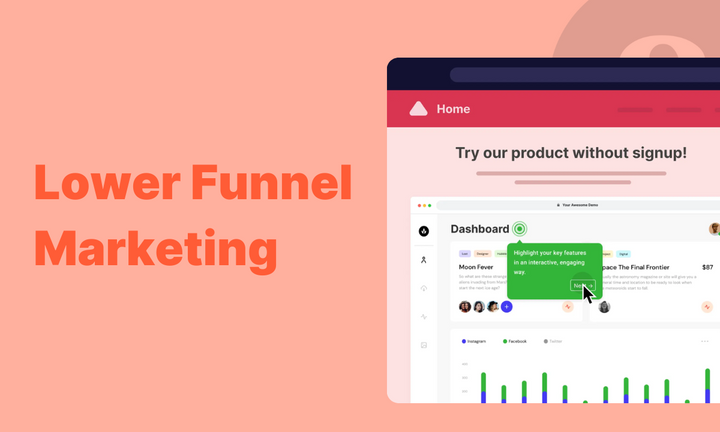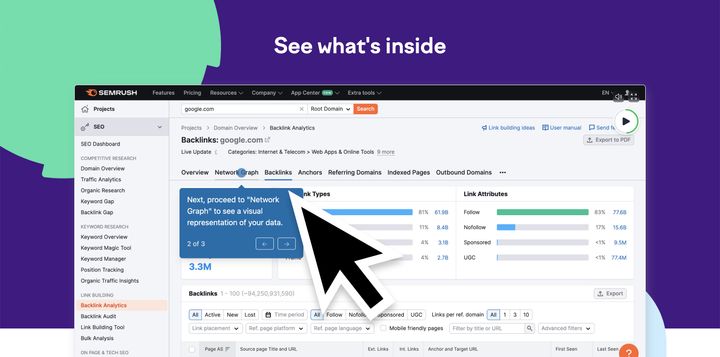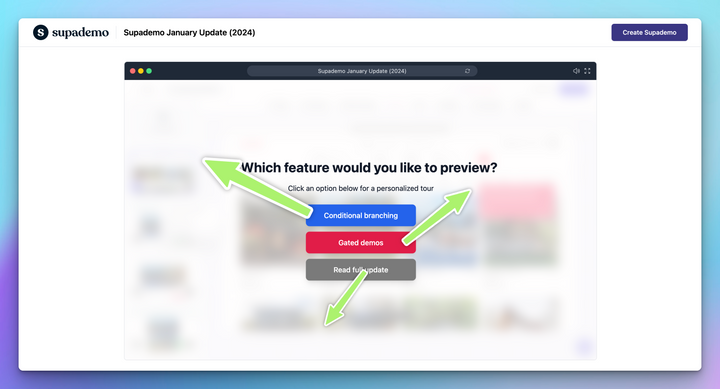Picture this: your sales team just finished a killer demo, the prospect nodded at all the right moments, and they even asked about pricing. Then... radio silence.
Sound familiar? You're not alone.
Most B2B SaaS companies excel at generating interest but struggle with the final conversion push. The prospects are there, the intent is high, but something's missing in those crucial last touchpoints.
That's where implementing lower funnel marketing tactics drives momentum.
In this blog, we discuss 10 fool-proof bottom-of-funnel tactics that eliminate hesitation, build confidence, and make saying "yes" the obvious choice for prospects who are already 80% of the way to a decision.
TL;DR
Tactics like interactive demos, case studies, ROI calculators, and live chat remove doubt, build confidence, and make purchase decisions easier.
What is lower funnel marketing?
Lower funnel marketing, also known as bottom-of-funnel, targets high-intent buyers near a decision and moves them from evaluation to purchase.
At this stage, buyers already know their problem and the solutions available. They’re evaluating vendors, comparing features, and seeking proof before committing.
Your goal is to remove doubt, prove value, and make the next step simple, such as starting a trial, requesting a quote, or making a purchase.
Top of funnel marketing vs lower funnel marketing
Top-of-funnel marketing builds awareness, while lower-funnel marketing converts high-intent buyers ready to decide. Let’s see a head-to-head comparison.
| Aspect | Top of Funnel Marketing | Lower Funnel Marketing |
|---|---|---|
| Primary Goal | Build brand awareness and attract prospects who may not even know they have a problem yet | Convert qualified prospects into customers by removing final purchase barriers and objections |
| Buyer Intent | Low to zero purchase intent — prospects are researching and learning about solutions | High purchase intent — prospects are comparing vendors and ready to make a decision |
| Audience Size | Broad, diverse audience with varied interests and pain points across different industries | Narrow, highly qualified audience that has shown specific interest in your solution category |
| Content Types | Educational blogs, industry reports, infographics, thought leadership content, and social media posts | Product demos, customer case studies, free trials, pricing pages, competitor comparisons, and testimonials |
| Messaging Focus | Problem-focused content that educates prospects without heavily promoting your product | Solution-focused content that positions your product as the best choice for their specific needs |
| Sales Cycle Stage | Awareness and initial interest phases when prospects are just discovering problems | Evaluation, decision, and purchase phases when prospects are ready to commit |
| Conversion Rates | Lower conversion rates since you're casting a wide net to capture early-stage prospects | Higher conversion rates because you're targeting qualified, ready-to-buy prospects |
| Cost Per Acquisition | Lower advertising costs since there's less competition for awareness-stage keywords | Higher advertising costs due to intense competition for high-intent, ready-to-convert prospects |
| Key Metrics | Website traffic, content engagement, social shares, brand awareness surveys, and email signups | Demo requests, trial conversions, sales qualified leads, deal velocity, and revenue attribution |
| Content Distribution | Requires consistent, high-volume content creation to maintain visibility and thought leadership | Focuses on fewer, higher-impact pieces that directly influence purchase decisions |
| Attribution Model | Difficult to measure immediate ROI since prospects may not convert for weeks or months | Easier to track direct impact since prospects convert quickly after engaging with content |
| Example Tactics | SEO blog posts, social media campaigns, industry webinars, and podcast sponsorships | Free trials, personalized demos, limited-time offers, sales presentations, and proposal meetings |
Top 10 lower funnel marketing tactics for SaaS companies
Bottom-of-funnel marketing is crucial for converting qualified prospects into paying customers. At this stage, your prospects understand their problem, have evaluated solutions, and are comparing vendors. Here are 10 fool-proof BOFU tactics to help you close more deals:
1. Interactive product demos
Interactive demos let prospects explore your product hands-on instead of passively watching a sales rep share screens. They work because buyers can complete real workflows at their own pace, see value in action, and revisit the demo whenever needed.
This shortens the sales cycle by eliminating scheduling friction and helping prospects experience the solution to their problem rather than just hearing about it.
Here are some ways you could use interactive demos -
How to implement?
AI-powered interactive demo platforms like Supademo make it straightforward to build high-converting demos.
Here’s a step-by-step approach:
- Map your workflow: Identify 3–4 core actions that best showcase your value proposition.
- Record your flow: Use the Supademo extension or app to capture pixel-perfect screens.
- Personalize the demo: Create variations by role, use case, or persona. Add AI voiceovers, explanatory text, and dynamic variables. Group multiple scenarios into a single showcase collection.
- Keep it focused: Limit each demo to under 5 minutes and highlight one specific use case instead of cramming every feature.
- End with a clear action: Add CTAs that guide prospects to the next step, such as starting a trial, booking a call, or downloading a resource. Supademo supports both internal and external links within demos.
- Track engagement: Measure how prospects interact with your demo by monitoring clicks, completion rates, drop-off points, and shares. Use these insights to identify high-intent accounts, prioritize follow-ups, and refine demo flows for higher conversions.
Beehiiv used Supademo to improve low conversion rates and unqualified sign-ups. By replacing static screenshots with interactive tours, they secured $10k in new contracts within two months, boosted free-to-paid conversions by 50%, and generated thousands of qualified sign-ups.

2. Case studies
Case studies and customer testimonials showcase real customers solving actual problems with your product. They provide social proof that moves prospects from "this looks interesting" to "this will work for me too."
As Robert Cialdini, author of Influence: The Psychology of Persuasion, explains:
“The principle of social proof says so: The greater the number of people who find any idea correct, the more the idea will be correct.”
Decision-makers use them to justify purchases to stakeholders, while buyers evaluating implementation or ROI see evidence from companies of similar size or industry.
How to implement?
- Choose diverse customers: Select success stories across different industries, company sizes, and use cases to cover your entire prospect base
- Focus on transformation: Structure stories with clear before/after scenarios showing specific business improvements
- Include hard metrics: Feature quantifiable results like "30% increase in revenue" or "50% reduction in processing time" rather than vague benefits
- Use multiple formats: Create written case studies, video testimonials, and one-page success summaries for different consumption preferences
- Make them findable: Embed relevant case studies in your sales materials, feature them on pricing pages, and create a searchable case study library
- Keep them fresh: Update case studies regularly with new results and add recent customer wins to maintain relevance
3. Competitor comparison pages
Competitor comparison pages show how your product stacks up against alternatives and help buyers make faster, more confident choices. They work because prospects at the bottom of the funnel are already evaluating features, pricing, and differentiators.
By addressing these criteria directly and transparently, you build trust, reduce decision anxiety, and capture high-intent searches like “Product A vs. Product B.” Well-optimized comparison content also brings strong SEO benefits by intercepting prospects who are ready to buy.
How to implement?
- Choose the format and competitors: You can create detailed landing pages (e.g., “X vs. Y”) or broader blog posts (e.g., “Top 5 Alternatives to X”) that clearly break down the difference.
- Create a feature matrix: Use a clean table showing side-by-side feature availability, pricing tiers, and unique differentiators
- Be transparent: Acknowledge competitor strengths while explaining why your solutions better address key pain points
- Add customer quotes: Embed short testimonials from switchers who moved from a competitor to your product
- Optimize for SEO: Include comparison keywords in headings, meta descriptions, and alt text
At Supademo, we implemented both approaches: blogs like Top 5 Storylane Alternatives and Top 7 Loom Alternatives capture high-intent searches.

Dedicated comparison pages, such as Meet the #1 Arcade Software Alternative, highlight clear differentiators.

4. Webinars
Webinars are live or on-demand sessions that combine product insights with industry expertise. They work because they let prospects see your solution in action, ask real-time questions, and engage with your team directly.
For decision-makers and stakeholders who need a deeper understanding before buying, webinars provide credibility, technical detail, and interactive proof that written content can’t match.
How to implement?
- Pick a focused topic: Solve one concrete challenge that aligns with your product’s strengths.
- Feature the right speakers: Mix product experts with respected industry voices to balance credibility and depth.
- Promote across channels: Use targeted email campaigns, paid ads, and in-app banners to drive attendance.
- Encourage engagement: Include live polls, product walk-throughs, and interactive Q&A to keep sessions dynamic.
- Close with a CTA: End by guiding attendees to the next step, such as booking a demo, starting a trial, or accessing a related case study.
5. Retargeting campaigns
Retargeting campaigns re-engage prospects who have already shown interest but have not converted.
By serving tailored ads or personalized emails based on a prospect’s past behavior, such as visiting your pricing page or abandoning a demo request, you keep your brand top of mind, reduce drop-offs, and drive them back into the sales process.
How to implement?
- Segment audiences: Create lists for pricing page visitors, demo request abandoners, and repeat blog readers
- Choose your retargeting method: Run paid ads on LinkedIn, Google Display Network, and Facebook for a broad reach, or use email nurturing sequences for higher engagement rates and personalized content delivery
- For email retargeting: Set up automated sequences triggered by specific behaviors—send ROI calculators to pricing page visitors, case studies to feature page browsers, and trial extension offers to users approaching expiration.
- Craft tailored messages: Highlight the next logical step based on their previous actions—"Ready to see pricing?" or "Unlock your free trial now"
- Set frequency caps: Prevent ad fatigue by limiting impressions per user or spacing emails 2-3 days apart in nurture sequences
- Measure and optimize: Track click-through rates, conversion rates, cost per acquisition, and email open rates to optimize performance
6. Free trials with guided onboarding
Free trials give prospects hands-on access to your product, while guided onboarding ensures they experience core value quickly. This tactic reduces risk, accelerates time-to-value, and creates “aha” moments that directly improve trial-to-paid conversion rates.
How to implement?
- Offer frictionless sign-up: Remove credit card requirements and minimize form fields
- Create interactive onboarding: Use tools like Supademo to build step-by-step guides that activate immediately after signup, showing users exactly how to complete their first key workflow
- Drive value milestones: Guide users through 3–5 essential actions—like creating a report or setting up an automation
- Send onboarding emails: Follow up with emails that reinforce in-app guidance and share best practices

- Provide real-time support: Offer chat or in-app messaging to answer questions during the trial
- Track engagement signals: Monitor completion of key actions and trigger personalized outreach to re-engage users who haven't hit important milestones within the first few days.
7. Limited-time offers and discounts
Limited-time offers create urgency by giving prospects a reason to commit now rather than later. They work because deadlines reduce decision paralysis, discounts lower financial barriers, and scarcity signals value.
For buyers who are stalling on price or timing, an expiring offer can accelerate sign-off and help you close deals faster.
How to implement?
- Define clear terms: Offer 10–30% discounts on annual plans or bonus features, with prominent expiration dates
- Use countdown timers: Add visual urgency with timers on pricing pages and in emails
- Target trial users: Send expiration reminders paired with exclusive deals to prospects approaching trial end
- Align with business cycles: Time offers around quarter-ends, budget planning seasons, or fiscal year closes when approval windows open
- Multi-channel promotion: Highlight deals in website banners, email campaigns, and retargeting ads
- Track impact: Monitor redemption rates, deal size changes, and time-to-close improvements
8. Product workshops/POCs
For complex deals, prospects often need more than a demo. Workshops and proof-of-concepts (POCs) provide a safe way to validate your product with real data and workflows. This hands-on exposure builds trust, satisfies technical requirements, and reduces risk, making final approval much easier.
How to implement?
- Set clear scope: Define specific outcomes and success metrics upfront to manage expectations
- Use real data: Work with your prospect's actual datasets and workflows rather than generic examples
- Involve their team: Include technical staff and end-users who will actually use the solution
- Document results: Create detailed reports showing performance improvements and ROI projections
- Time-box the process: Limit POCs to 2-4 weeks to maintain momentum and urgency
Bullhorn uses Supademo to build sandbox demos that allow prospects to test workflows safely without exposing sensitive data.
By simulating real scenarios, they reduce evaluation risk and give buyers hands-on validation before committing. The result: faster deal cycles, greater stakeholder confidence, and a measurable lift in conversion rates during late-stage sales.
9. ROI calculators
ROI calculators help prospects quantify the financial impact of your solution, turning abstract benefits into concrete numbers they can share with stakeholders.
This tactic works for enterprise buyers who need a clear business case to secure budget, and for finance teams evaluating cost versus benefit.

How to implement?
- Gather benchmarks: Use customer success data and industry research to define average ROI metrics such as time saved or cost reduced
- Build the calculator: Develop a web-based tool that asks for key inputs like user count, current costs, and expected efficiency gains
- Offer customization: Allow users to adjust variables—overhead costs, license fees, and growth rates—to see personalized projections
- Enable report downloads: Provide one-click export of a branded PDF or PowerPoint summary for decision-makers
- Embed strategically: Place the calculator on pricing pages, case study pages, and demo sign-up forms to capture high-intent users
- Track engagement: Monitor how often the calculator is used, how many reports are downloaded, and the subsequent demo or trial sign-ups
HubSpot offers several ROI calculators tailored to different buyer needs, including marketing ROI, sales productivity, and ad spend efficiency. Each tool generates personalized projections and shareable reports that prospects can take to internal stakeholders. This approach helps champions secure budget approval, shortens sales cycles, and improves win rates against competitors.
10. Live chat on website
Live chat connects high-intent visitors with your team in real time. It works because prospects browsing pricing or demo pages often have last-minute questions that block conversion.
By providing instant answers, you reduce friction, capture leads before they bounce, and create a smoother path to booking demos or starting trials.
How to implement?
- Select a chat platform: Choose tools like Drift, Intercom, or HubSpot Chat that integrate with your CRM and marketing automation
- Set behavioral triggers: Automatically open chat when visitors spend over 60 seconds on the pricing page or return multiple times
- Staff strategically: Staff chat with sales or support reps trained to qualify leads, answer technical questions, and book meetings
- Use chatbots for basics: Handle common queries like pricing tiers or feature availability with bots, then route complex questions to humans
- Personalize greetings: Reference the visitor’s company or pages viewed to show context and relevance
- Track chat outcomes: Monitor chat engagement rates, qualified leads generated, meeting bookings, and conversion rates
Start using interactive demos today!
Winning at the bottom of the funnel is about removing doubt and making action the easy choice. Tactics like case studies, ROI calculators, and comparison pages help, but interactive product demos stand apart. They give buyers hands-on validation, shorten the sales cycle, and work 24/7 without scheduling friction.
Supademo makes this effortless. You can create interactive demos that capture the essence of your product and present even complex workflows with clarity. Delivered as self-serve showcases, embedded in comparison pages, or explored in sandbox environments, these demos give prospects undeniable proof of how your solution works. The result: greater confidence, faster evaluations, and more deals closed.
Ready to move buyers from evaluation to purchase? Try Supademo and deliver demos that convert hesitation into action.
FAQs
What is upper funnel and lower funnel marketing?
Upper funnel marketing focuses on awareness and demand generation, attracting prospects who are just learning about your brand. Lower funnel marketing targets high-intent buyers ready to decide. Together, they guide prospects from discovery to purchase, ensuring your pipeline is both full and conversion-ready.
What is an example of a lower funnel objective?
A lower funnel objective is converting qualified leads into paying customers. For SaaS, this could mean driving free trial users to paid plans, securing signed contracts, or reducing sales cycle length. The focus is measurable actions that directly impact revenue rather than broad engagement metrics.
Why is lower funnel marketing important?
Lower funnel marketing is critical because it directly influences revenue. Buyers at this stage are evaluating vendors and weighing purchase decisions. By addressing objections, providing proof, and reducing friction, you increase conversion rates, accelerate deal velocity, and turn pipeline opportunities into actual paying customers.
What are common lower funnel tactics?
Common lower funnel tactics include interactive product demos, case studies, competitor comparison pages, ROI calculators, free trials with guided onboarding, retargeting campaigns, and live chat. Each removes barriers to purchase, proves value, and gives stakeholders the confidence to move forward with a buying decision.




